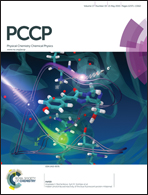Temperature-induced molecular transport through polymer multilayers coated with PNIPAM microgels†
Abstract
Polyelectrolyte multilayers serve as effective reservoirs for bioactive molecules which are stored and released from the multilayers for cellular applications. However, control over the release without significantly affecting the multilayers and biomolecules is still a challenge. On the other hand, externally stimulated release would make the multilayers promising for the development of stimuli-sensitive planar carriers with release performance switched on demand. In this study soft composite films are designed by coating hyaluronic acid/poly-L-lysine (HA/PLL) multilayers with temperature responsive poly(N-isopropylacrylamide) (PNIPAM) microgels. Microgels are flattened and immersed into the multilayers to maximize the number of contacts with the surrounding polyelectrolytes (HA and PLL). The microgel coating serves as an efficient switchable barrier for the PLL transport into the multilayers. PLL diffusion into the film is significantly hindered at room temperature but is dramatically enhanced at 40 °C above the volume phase transition temperature (VPTT) of PNIPAM at 32 °C associated with microgel shrinkage. Scanning force microscopy micrographs show that the mechanism of volume phase transition on soft surfaces cannot be directly deduced from the processes taking place at solid substrates.


 Please wait while we load your content...
Please wait while we load your content...